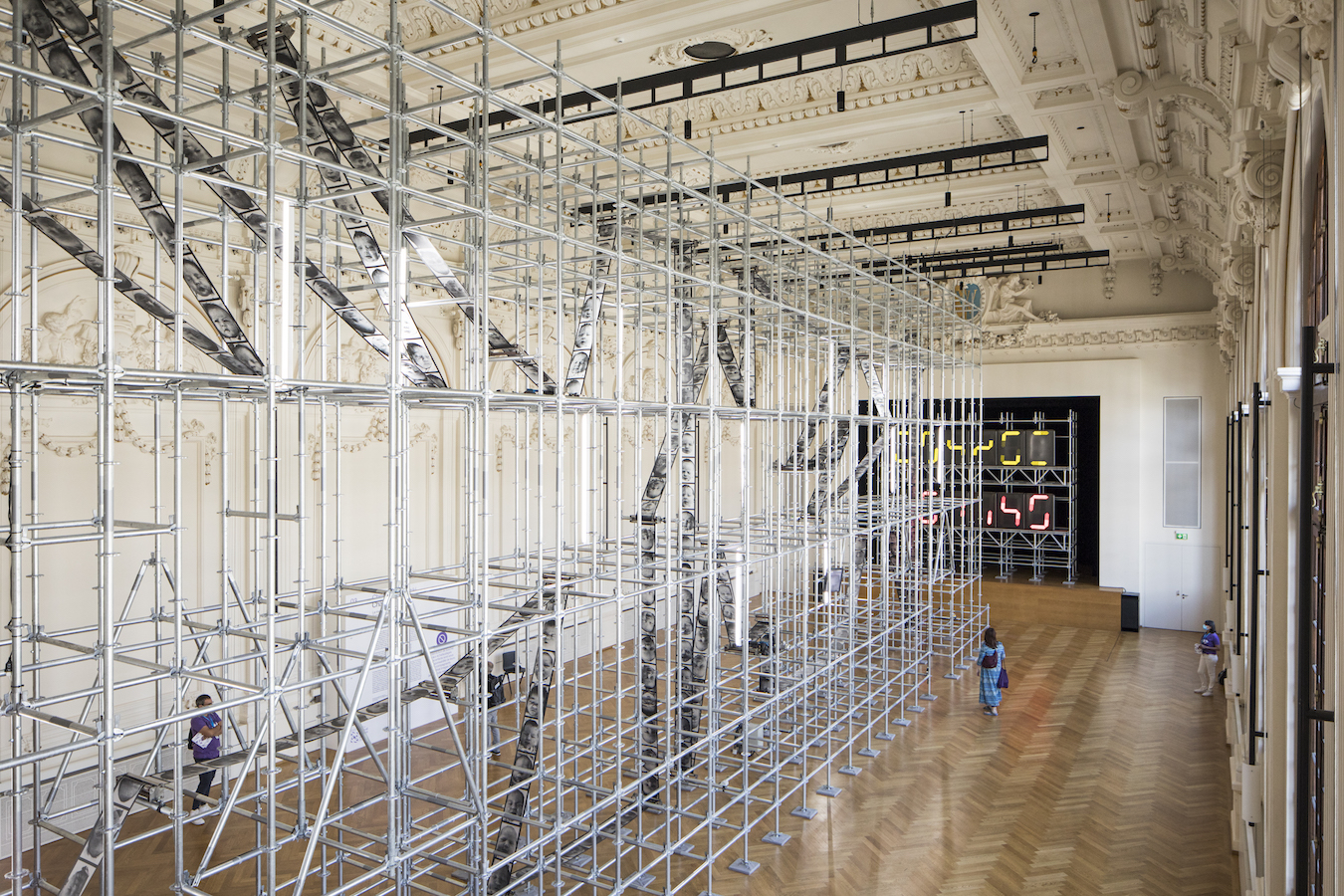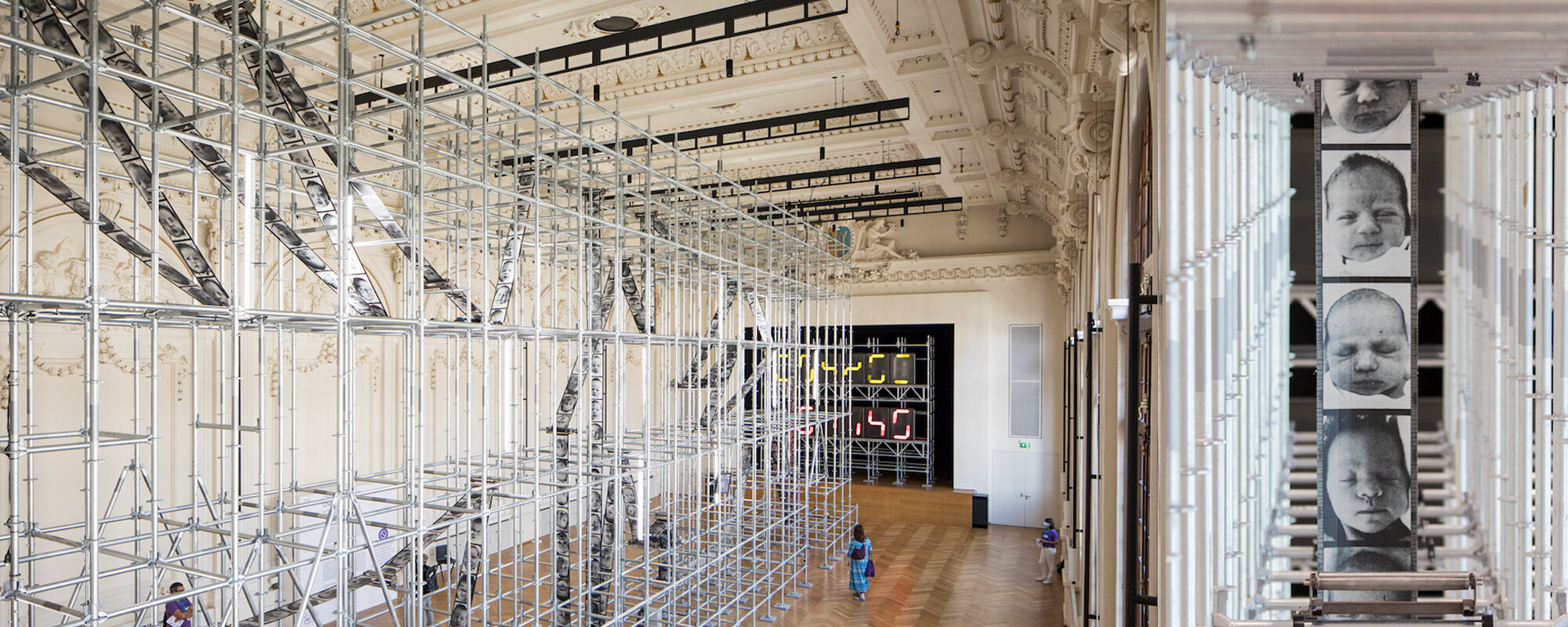“Lake Geneva is situated along the borders of France and Swtizerland and is surrounded by dauntingly beautiful Chablis Alps, which features Le Grammont,-the region’s highest summit”
I had the pleasure of visiting the Swiss Biennale Festival Images Vevey last week. The festival, which occurs every two years in the small, but lush town of Vevey, is an outdoor festival with an emphasis on lens-based images, but also includes installation and digital art (if that’s a term “sighs betraying his limitations”). The festival is outdoors and indoors and exhibitions occupy various interesting halls, theatres and pharmacies through the town. There is an emphasis on public exhibitions of work throughout the lakeside community with parks and waterfront locations being emphasized.
To state the obvious, Vevey is an incredible location to have a festival. Lake Geneva is situated along the borders of France and Switzerland and is surrounded by the dauntingly beautiful Chablis Alps, which features Le Grammont,-the region’s highest summit. This summit also features another mountain Lake-Lac de Taney. The location is simply sublime, unreal and provides a calm and relaxed backdrop for an outdoor festival. Many festivals are placed in urban environments to encourage local visitation. Though I have been to a number of festivals in my time, I do not recall any that have the location-specific beauty of Vevey in a late summer day. It is hard not to feel like it is a movie set in some respects.
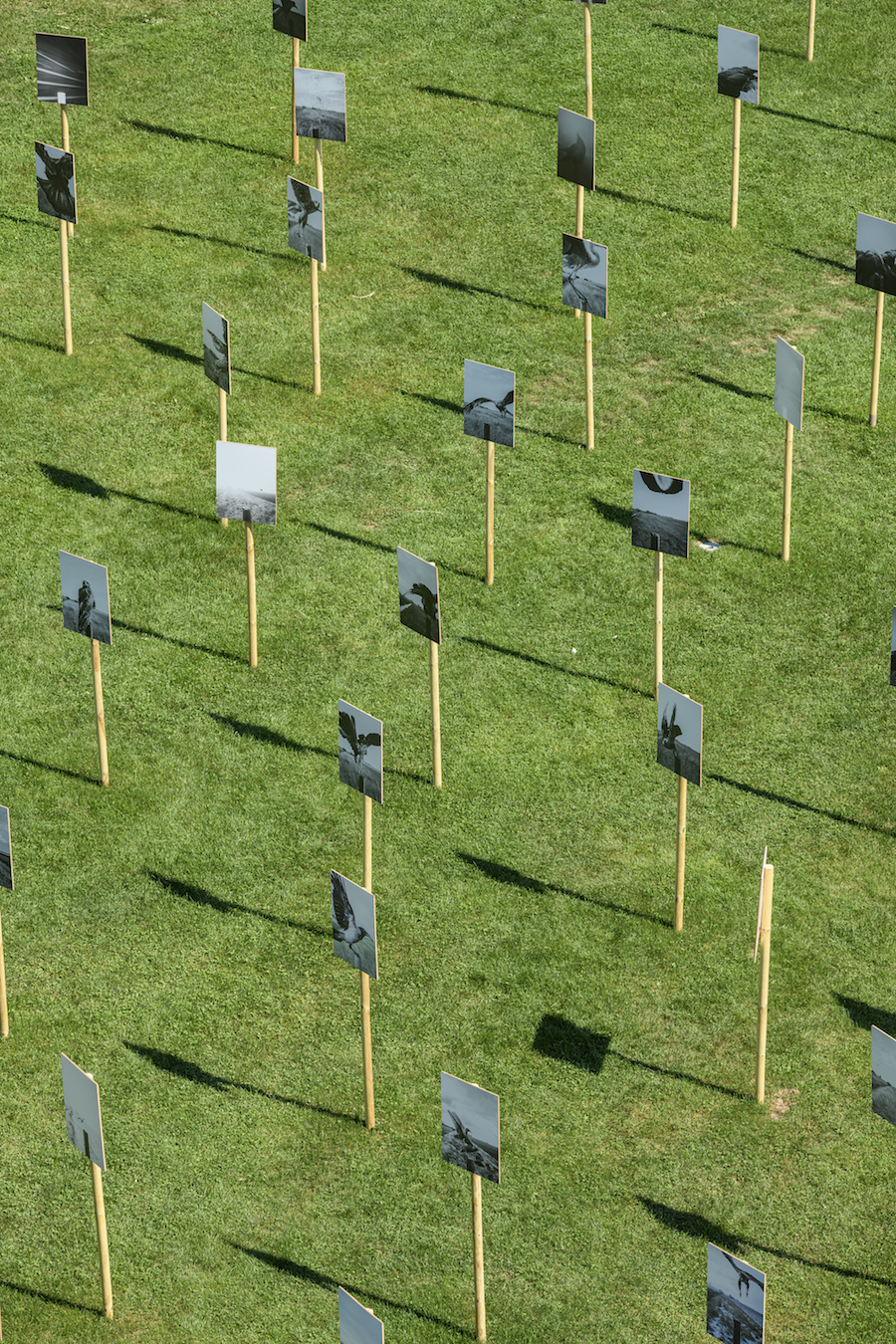
Stephen Gill, The Pillar
This year’s festival and its curation operate under the title Unexpected. For obvious reasons, the 2020 edition remit carries an impactful weight as we struggle through a year of unexpected difficulty from Covid19 to the current and ongoing political moment in America and abroad. The title also reflects the use of exhibition space and where one may bump into works situated in unexpected places. I found myself confronted with a Stephen Gill rendition of his excessively brilliant The Pillar while rounding the corner of a castle. It was set in a small green just behind a children’s playground where visitors could duck in and out of the mass of photography pinned to the top of a similar pillar structure featured in Stephen’s photographs. I even managed to bump into Stephen between the posts with artist Jack Latham.
Jack Latham’s installation Beggar’s Honey- Chapter I: Latent Bloom is one of the more fascinating pieces in the festival for me for a number of different reasons. Firstly, it should be mentioned, that Jack was the winner of the Heidi.news Prize. Latent Bloom is constructed from a algorithmic process in which the artist invokes the algorithm to seek and create images of floral still life’s that glitch and distort seen on two television screens in situ. The room is wallpapered from floor to ceiling with different versions of these flowers “becoming” in still frame questioning arguably the algorithm’s right to life representation. The work is further supplemented by a book that the festival co-published with Here Press. I will be covering that portion of Jack’s new work very soon on a different channel. It was an important step for the artist to have the opportunity provided by the Festival for the development of his work, which is generally-speaking, an incisive re-thinking of the documentary tradition.
“The room is wallpapered from floor to ceiling with different versions of these flowers “becoming” in still frame questioning arguably the algorithm’s right to life representation”
What Festival Images Vevey is noted for is allowing work by budding or young artists such as Latham or Juno Calypso whose What to Do With a Million Years stood out for this very reason, is an opportunity to take chances or risk new installations and arrangements of their work. In the case of Calypso, her work was installed in a concrete bunker on the lakeside and in my estimation charged the work with an even more uncanny and uncomfortable investigation of sci-fi domesticity and power roles of selfie culture that Calypso is known for. Of course, the images are highly aestheticized and the preferred pinks and blues of her interiors are offset by the morose and claustrophobic hushing grey walls of the bunker. There is a mirror mounted on the ceiling, which also provides the viewer with a doubling affect, which extends the space, but compresses the walk to the final room in a manner suited to uncertainty. It is highly successful and adds further layers to the work.
Not all of the spaces were in open public areas, nor were they exhibited outside of a more conventional format. Thomas Sauvin and Kensuke Koike’s No More, No Less was installed next to the main hall in a small step-down gallery space perfectly suited to a more conventional hanging of their very unconventional material. As noted previously in a review on ASX, the work features the use of Sauvin’s dense Beijing Silvermine archive coupled with the precision of Koike’s optical effrontery as a master montage-ist. As someone familiar with the work, I found joy in seeing it exhibited and there is also a workstation in the exhibit that encourages public experimentation.
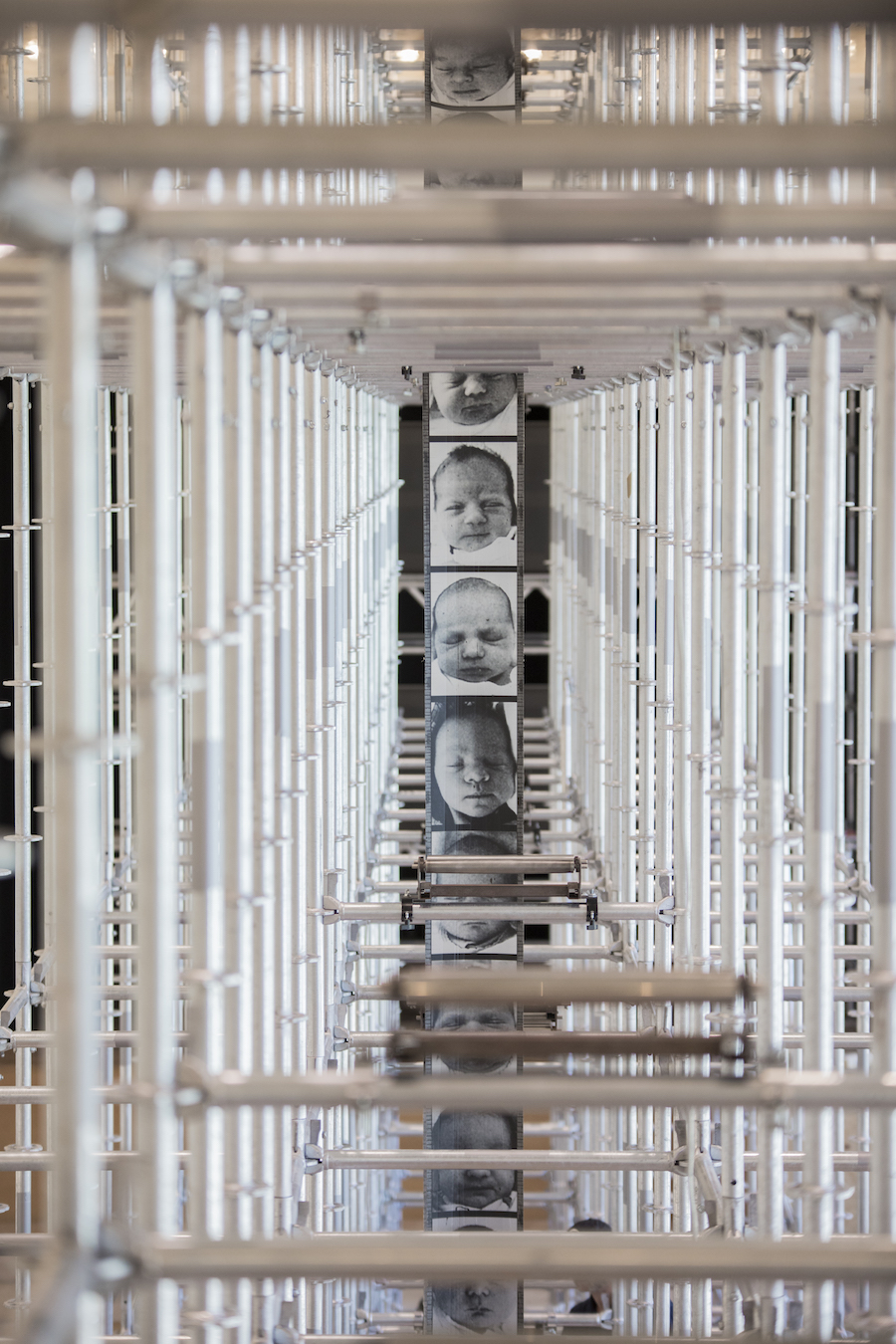
Christian Boltanski, Chance
In the main hall next their exhibition is the behemoth piece Chance by Christian Boltanski, an extremely respected Artworld doyen. He happens to be one of my earliest influences and seeing his monolithic piece installed through out the hall was a pleasure. Chance is hard to describe in words. It is a large scaffolding structure in which a conveyor belt has been mounted through its mid-section which dwarfs the viewer filling the space between 2.5 stories from floor to ceiling. On the conveyor belt there is a succession of images of newborn babies clipped and enlarged from local Polish newspapers-all are illuminated by a digital clock or counter, rather in the background. The idea is that to be born is to be thrown into the world in which your pre-cognizant self has little or no control over the where and when or to the family and situation into which you will be born. There are a number of undetermined factors at our arrival and the piece reflects a heavy mediation on time, fate and the potential towards chaos. By size alone, I was impressed. By content, I was floored.
In the same hall and on the second floor Nico Krebs and Taiyo Onorato’s È tempo ormai di dirti addio. It is an impressive screen installation of a performance filmed in Gibellina, Sicily in which the duo, with their fascination with all things “road” performed and recorded a “hyperreal four wheeled character crisscrossing the empty streets of Gibellina playing wistful Italian songs” thus emphasizing the value of place, but also transport and shifting perspectives of view and authorships. It’s a great piece and Gibellina, a town struck and raised by a massive earthquake, is a new playground for artists wishing to explore the function of budding utopias and solitude. It offers a similar festival in which Festival Images Vevey has a co-operation with.
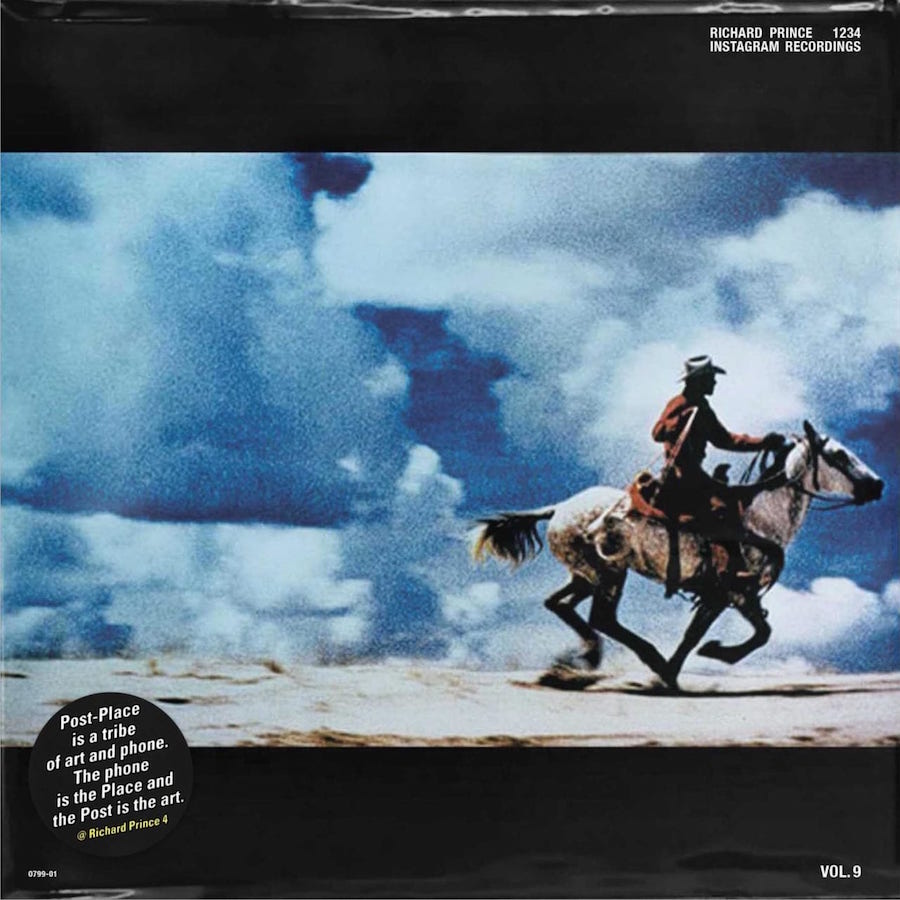
Sebastien Girard, Richard Prince 1234 Instagram Recordings
In terms of a non-public space used wisely is Sebastien Girard’s Richard Prince 1234 Instagram Recordings, a comical piece of homage to the American appropriation artist in which Girard took over a local record shop and displayed 700 images from Prince’s own now deleted Instagram account. The turn here is to acknowledge that the “theft” of Prince’s images are based on his own “theft” of other people’s images that Girard was wise enough to habitually, through the use of an app download Prince|s images before Prince cancelled the account. This entitled Girard to re-appropriating the work into faux-record covers which the shop stocks as if “real”. It is a purposefully dubious and brilliant piece of work and one of my personal favorites as a vinyl enthusiast and dispassionate Prince critic.
“It is a purposefully dubious and brilliant piece of work and one of my personal favorites as a vinyl enthusiast and dispassionate Prince critic”
Outside of Girard’s exhibition were a number of outdoor installations by Peter Funch (42nd and Vanderbilt) Jeff Mermelstein (SideWalk), and Batia Suter (Ice, Birds, and Fire(in this case). All were situated close to the station and quite enjoyable to run into. I was able to see people interact with Funch’s work as it was on the ground and Suter and Mermelstein cast huge glances across the tramline. Venturing further, I ran into a outdoor sport ground with picnic table and found (rightly so) Hayahisa Tomiyasu’s excellent TTP adoring the grounds. I had written about the MACK First book Award winner in 2018 and still absolutely love the work, which is playful, durational and single-minded. The piece features Tomiyasu’s record of four years of photographing the goings on of one solitary ping pong table from his Leipzig window. It still makes me smile when I type this. Gloria Oyarzabal’s Woman Go No’ Gree also adorned an outside space confronting the viewer with questions about authorship, gender roles, and colonial imagers. Her book was also published with the festival and Editorial RM. It is a fascinating and complex proposition. I will be interviewing her soon.
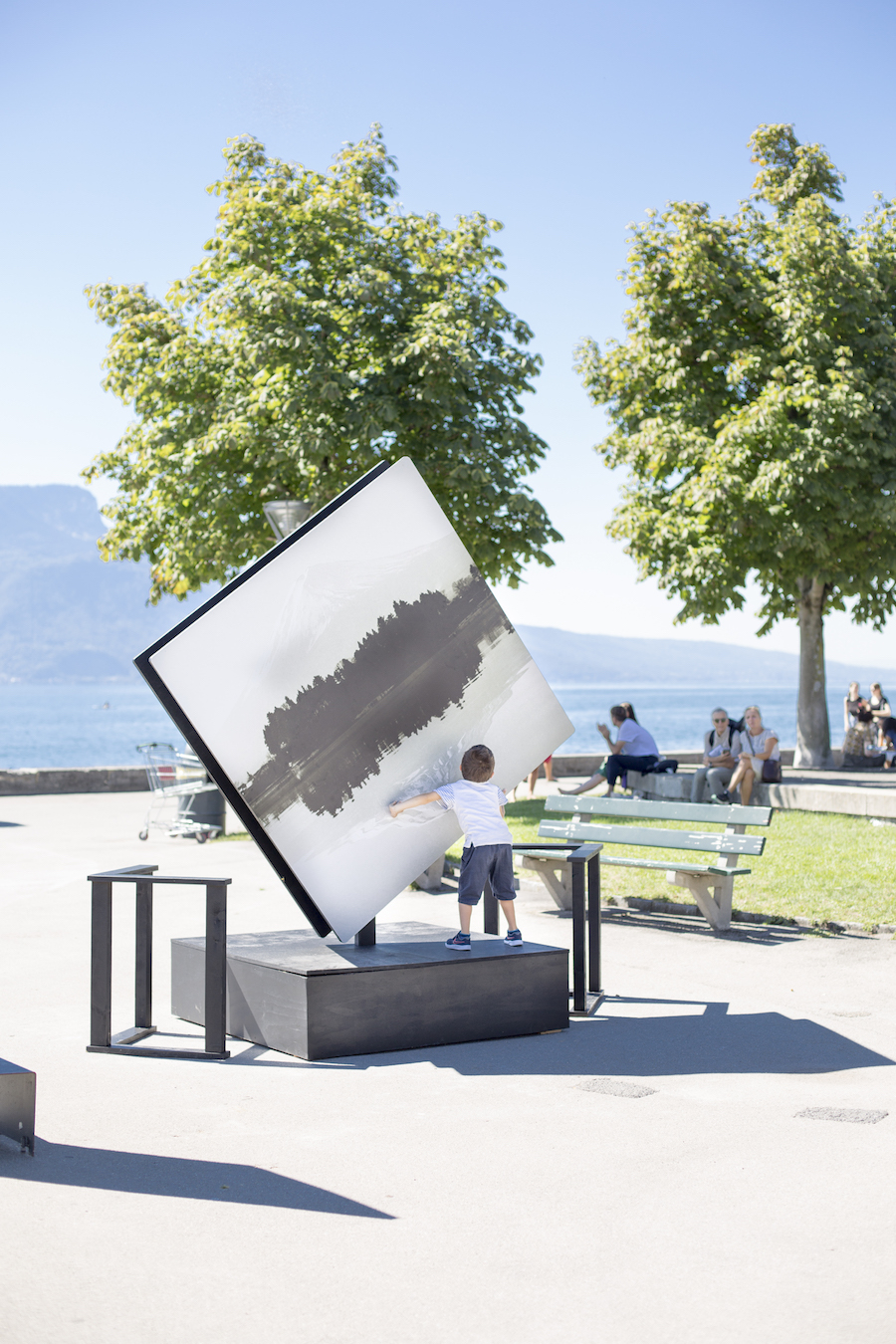
Other standouts for the festival included Jean-Marie Donat’s Rorschach; a vernacular project in which the artist and collector uses his found images of reflections to swirl, up-turn and to create a mirror or doubling affect much like the psychological application found within the name. Aladin Borioli’s Ruches-an archival project about the history of beekeeping and associated book published with the festival is a brilliant nod to the natural world, but also bee heraldry and human invention and custom. I will feature the book in the coming weeks as I very much enjoyed it. It was also refreshing to see the work in the same festival as Batia Suter and Jean-Marie Donat as it expressed our nascent archival impulse to re-examine the production of photography and ephemera that has been overlooked. Penelope Umbrico’s Range: Of Mount Grammont With Light-Leak Camera App Filters is a screen and technological re-purposing of images of Mount Grammont situated on the lakefront close the the sweeping view of the summit which was pertinent and reflected the ever-changing notion of the natural sublime in correlation to tits correlative value or the techno-sublimity of its registration on the screen-a fun note about this piece is that at points, the sun would literally pierce the images on display and carry on through the mountain that the images depicted. In effect the sun pierced the immovable behmoth of earth and rock. Alina Frieske’s Abglanz, her digitally painted, re-stitched and sutured portraits reminded me of Lucien Freud and perhaps Daniel Gordon, but with the foreknowledge that her process is lengthy, minute and operates on a scale of build-up not generally found in physical collage making. I expect great things from her going forward.
“Penelope Umbrico’s Range: Of Mount Grammont With Light-Leak Camera App Filters is a screen and technological re-purposing of images of Mount Grammont situated on the lakefront close the the sweeping view of the summit which was pertinent and reflected the ever-changing notion of the natural sublime in correlation to tits correlative value or the techno-sublimity”
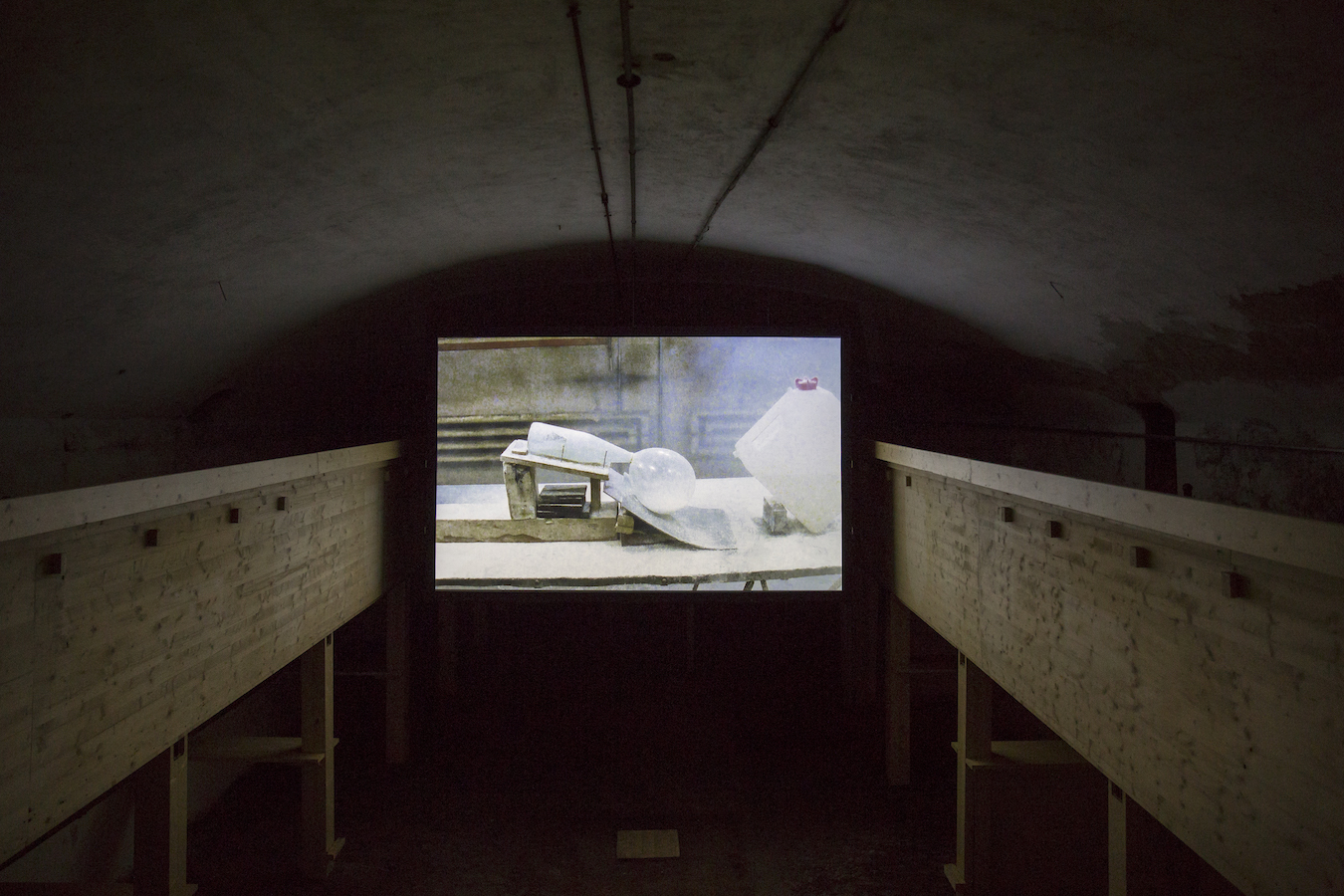
Finally, there were three pieces or installations that I absolutely cherish having seen in person. The first is perhaps is seeing Fischl & Weiss’ 1987 opus Der Lauf Der Dinge, a video-performance piece in which competition, chance and motivation are played out in a warehouse somewhere in the 80’s under the direct rule of knives, fire, flame, gravity and chemical reaction. The piece is pretty well-known but is in effect the archetype of what youtube kids are doing presently during Corona lockdown with the contents of garages, attics and basements. The idea is to put into a motion a series of events from one point of movement (not unlike the Boltanski) and the fate of the reaction is pre-determined by the artists ability to set up the objects ahead of the movement to continue the chain reaction-like dominoes, but dominoes that go up a ladder, knock over a can of petrol onto a flame, connected to a helium tank which expands balloon, releases, drifts overhead and ruins into the sharp point of a serrated hunting knife where it falls onto y brick levelled on a broomstick, which accidently starts sweeping marbles into the ass end of a pig which squeals and runs toward another knife. Most of this analogy I have made up of course, but you get the idea. It was true pleasure to watch in an old pharmacy in which a stage had been built above the original dirt floor.
Another outstanding piece at the festival was Vincent Jendly’s Lux in Tenebris, a film and photographic installation in which the artist confronts his childhood fears of drowning. The artist whose childhood brush with a drowning death spent time at sea on cargo ships photographing the daily life of the ship’s inhabitants, but also roaring and looming waves crashing onto the ship which look truly apocalyptic. The installation was incredibly successful with an emphasis of feeling as though one was caught at the beginning in darkness only to surface through the light at the end of the installation where the rooms were more brightly lit.
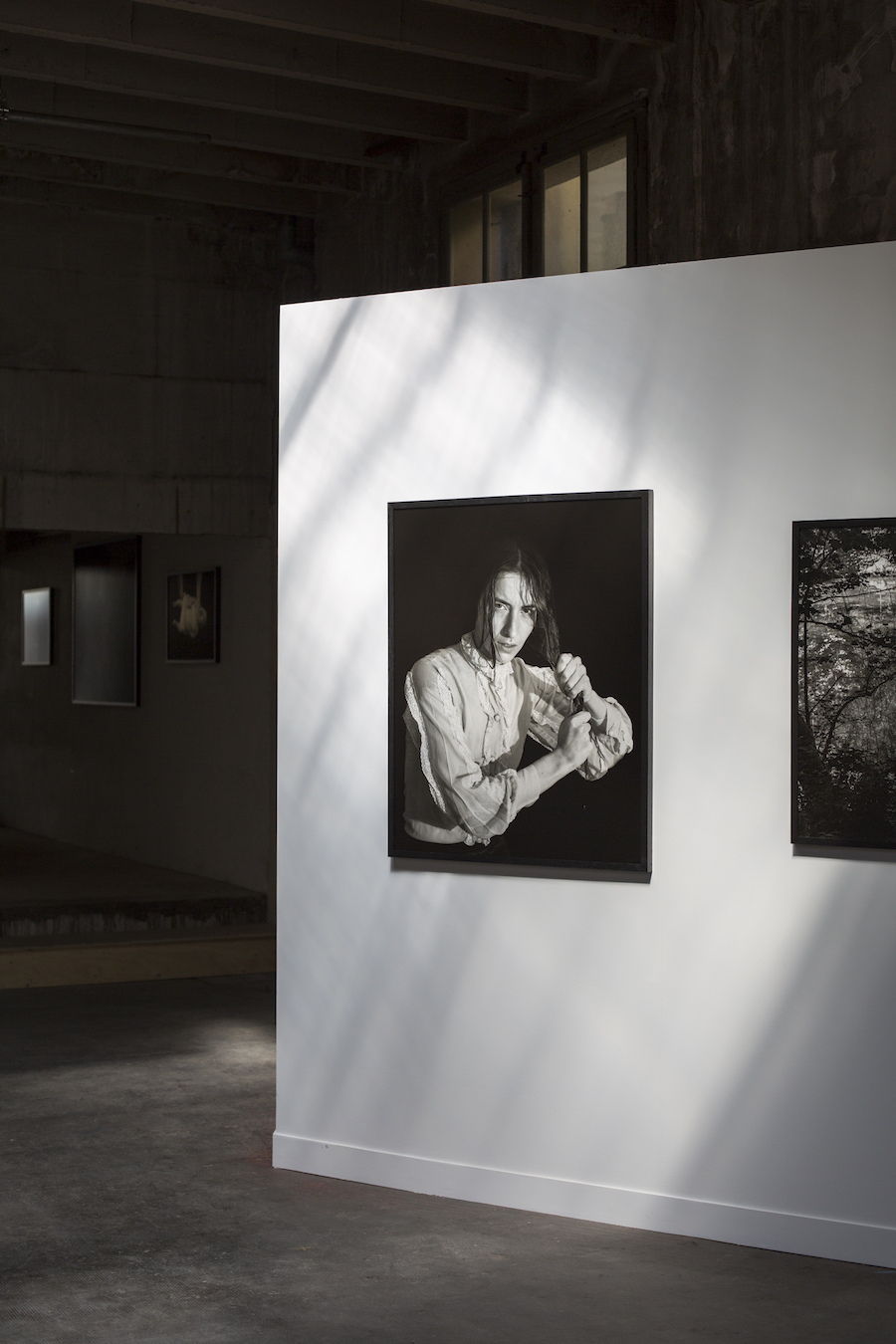
I do not know if it’s proper to say “favorite” or not, but the work that I anticipated seeing most and was the most overcome to see was the winner of Grand Prix Vevey Award Kristine Potter’s Dark Waters. The installation featured photographs, film and sound that echoed through a disused garage. I am familiar with the work having interviewed Kristine before for Nearest Truth, but it was really amazing to see the American artist work “live”. The soundtrack of a murder ballad playing from inside the video room presented a haunting element that I had not experienced before. It exemplified best the sorrow and difficulty found in the lyrics of the ballads themselves. Kristine’s work, which is a reflection of the American South, its deep gothic nature and the stories found within the murder ballads themselves of drowned women, lament and a deep biting reflection (intended) about how these songs are formed stood out for the weight of concept the artist wished to speak on. It is about the relationship women share to water, alive and dead and it is rightly baroque and brooding. It was an overpowering moment, even on a sunny day and left me pondering being close to such a large lake. I cannot wait for that book….
“Kristine’s work, which is a reflection of the American South, its deep gothic nature and also of course, the stories found within the murder ballads themselves of drowned women, lament and a deep biting reflection (intended) about how these songs are formed”
Festival Images Vevey presents an experimental lab where risk is encouraged. The curators of the festival are on hand all of the time and due to the relaxed environment, you are almost expected to bump into the artists and festival director during your stay. It is accessible and it gives pause to think about what the aims of a festival should be in its utilizing of public space that operates throughout the city. It is international and possibly the only lens-encouraged festival in which other art forms are also suggested. The landscape also makes it something of an unreal experience. Stefano Stoll, the director mentioned to me that he wants people and artists to come to the festival to relax and enjoy themselves. It sounds like a simple idea, but for my two cents, he has been super successful. I look forward to the next edition, but also the ever-expanding shelf of their festivals, publications and their future co-operation with the Gibellina festival.
